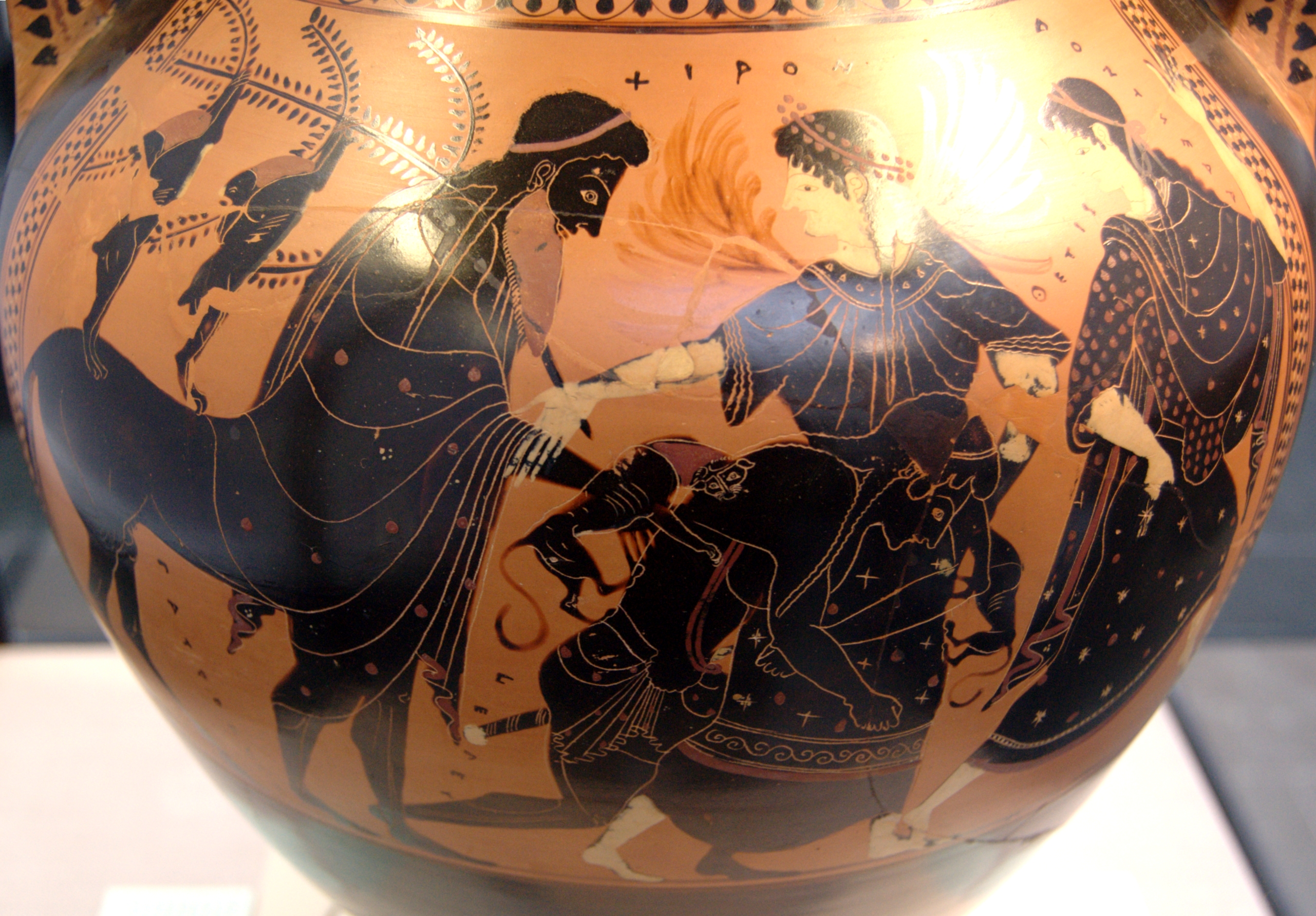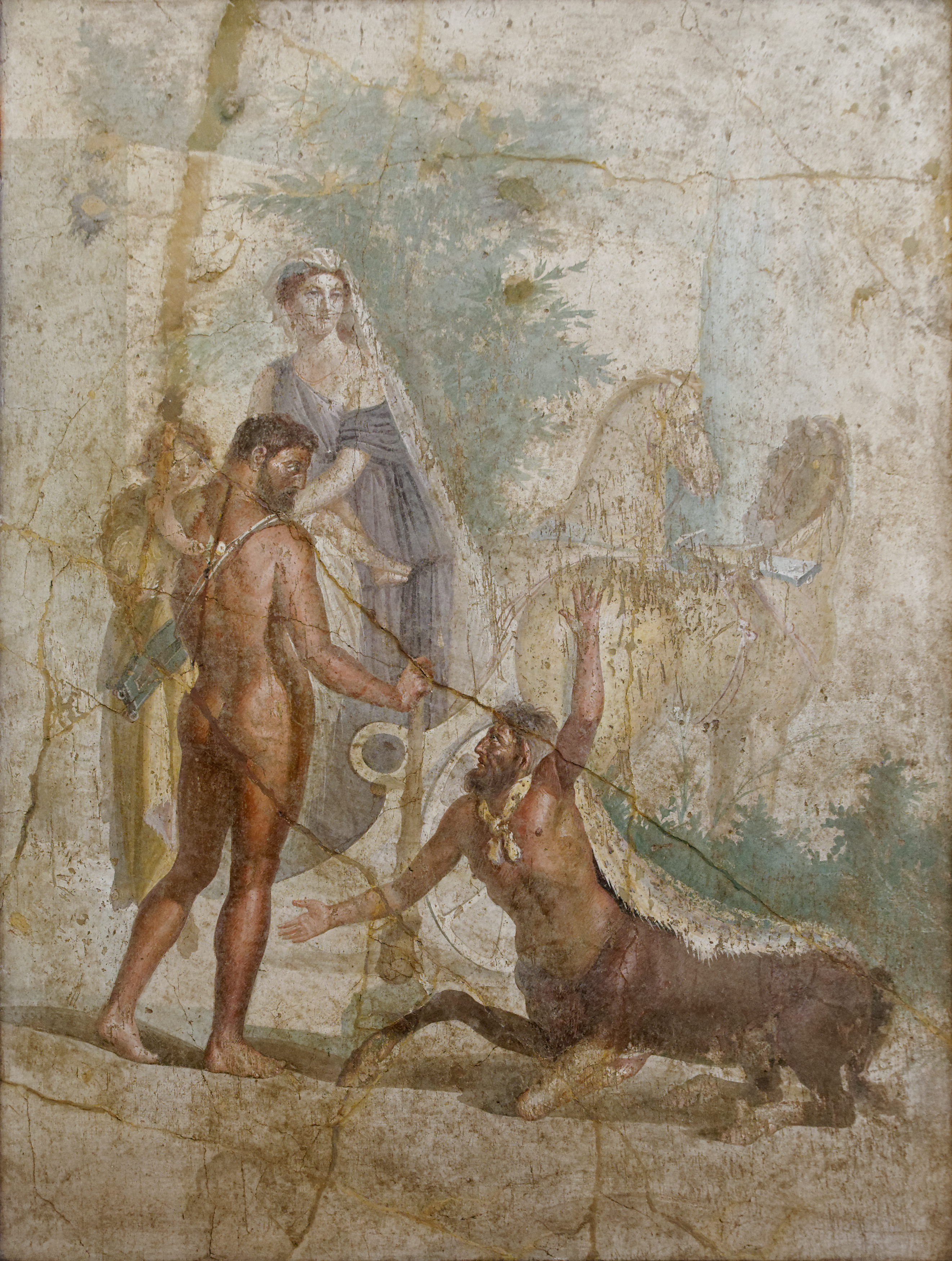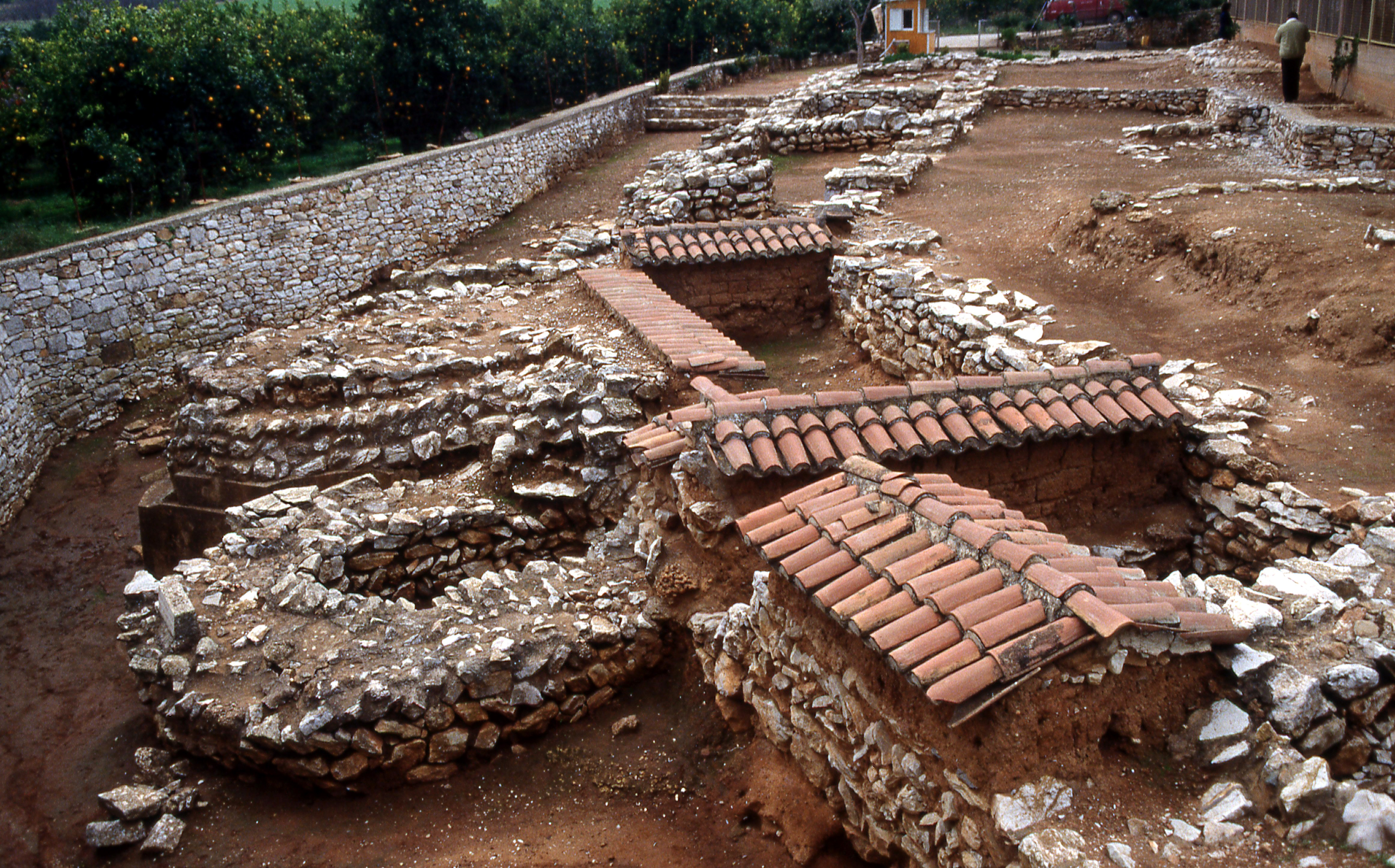|
Dragons In Greek Mythology
Dragons play a significant role in Greek mythology. Though the Greek ''drakōn'' often differs from the modern Western conception of a dragon, it is both the etymological origin of the modern term and the source of many surviving Indo-European myths and legends about dragons. Origins The word dragon derives from the Greek ''δράκων'' (drakōn) and its Latin cognate ''draco''. Ancient Greeks applied the term to large, constricting snakes. The Greek ''drakōn'' was far more associated with poisonous spit or breath than the modern Western dragon, though fiery breath is still attested in a few myths. There is also the ''drakaina'', the specifically female form or "she-dragon." The ''drakaina'' is occasionally treated differently from the more common masculine or gender-neutral ''drakōn'', often surviving by mating with a hero or being the ancestress of an important lineage. Daniel Ogden speaks of three ways to explain the origins of Greek dragon myths: as ''vertical'' evolutio ... [...More Info...] [...Related Items...] OR: [Wikipedia] [Google] [Baidu] |
Dragon Louvre N3157
A dragon is a magical legendary creature that appears in the folklore of multiple cultures worldwide. Beliefs about dragons vary considerably through regions, but dragons in Western cultures since the High Middle Ages have often been depicted as winged, horned, and capable of breathing fire. Dragons in eastern cultures are usually depicted as wingless, four-legged, serpentine creatures with above-average intelligence. Commonalities between dragons' traits are often a hybridization of reptilian, mammalian, and avian features. Etymology The word ''dragon'' entered the English language in the early 13th century from Old French , which, in turn, comes from Latin">-4; we might wonder whether there's a point at which it's appropriate to talk of the beginnings of French, that is, when it wa ... , which, in turn, comes from Latin (genitive ), meaning "huge serpent, dragon", from , (genitive , ) "serpent". [...More Info...] [...Related Items...] OR: [Wikipedia] [Google] [Baidu] |
Typhon
Typhon (; , ), also Typhoeus (; ), Typhaon () or Typhos (), was a monstrous serpentine giant and one of the deadliest creatures in Greek mythology. According to Hesiod, Typhon was the son of Gaia and Tartarus. However, one source has Typhon as the son of Hera alone, while another makes Typhon the offspring of Cronus. Typhon and his mate Echidna were the progenitors of many famous monsters. Typhon attempted to overthrow Zeus for the supremacy of the cosmos. The two fought a cataclysmic battle, which Zeus finally won with the aid of his thunderbolts. Defeated, Typhon was cast into Tartarus, or buried underneath Mount Etna, or in later accounts, the island of Ischia. Typhon mythology is part of the Greek succession myth, which explained how Zeus came to rule the gods. Typhon's story is also connected with that of Python (the serpent killed by Apollo), and both stories probably derived from several Near Eastern antecedents. Typhon was (from ) also identified with the Egyptian god o ... [...More Info...] [...Related Items...] OR: [Wikipedia] [Google] [Baidu] |
Chiron
In Greek mythology, Chiron ( ; also Cheiron or Kheiron; ) was held to be the superlative centaur amongst his brethren since he was called the "wisest and justest of all the centaurs". Biography Chiron was notable throughout Greek mythology for his youth-nurturing nature. His personal skills tend to match those of his foster father Apollo, who taught the young centaur the art of medicine, herbs, music, archery, hunting, gymnastics, and prophecy, and made him rise above his beastly nature. Chiron was known for his knowledge and skill with medicine, and thus was credited with the discovery of botany and pharmacy, the science of herbs and medicine.Pliny the Elder, ''Natural History (Pliny), Naturalis Historia'7.56.3/ref> Like satyrs, centaurs were notorious for being wild, lusty, overly indulgent drinkers and carousers, violent when intoxicated, and generally uncultured delinquents. Chiron, by contrast, was intelligent, civilized, and kind, because he was not related directly to th ... [...More Info...] [...Related Items...] OR: [Wikipedia] [Google] [Baidu] |
Centaur
A centaur ( ; ; ), occasionally hippocentaur, also called Ixionidae (), is a creature from Greek mythology with the upper body of a human and the lower body and legs of a horse that was said to live in the mountains of Thessaly. In one version of the myth, the centaurs were named after Centaurus (Greek mythology), Centaurus, and, through his brother Lapithes (hero), Lapithes, were kin to the legendary tribe of the Lapiths. Centaurs are thought of in many Greek myths as being as wild as untamed horses, and were said to have inhabited the region of Magnesia (regional unit), Magnesia and Mount Pelion in Thessaly, the Foloi oak forest in Ancient Elis, Elis, and the Malean peninsula in southern Laconia. Centaurs are subsequently featured in Roman mythology, and were familiar figures in the medieval bestiary. They remain a staple of modern fantastic literature. Etymology The Greek word ''kentauros'' is generally regarded as being of obscure origin. The etymology from ''ken'' + ''tau ... [...More Info...] [...Related Items...] OR: [Wikipedia] [Google] [Baidu] |
Cancer (constellation)
Cancer is one of the twelve constellations of the zodiac and is located in the Northern celestial hemisphere. Its name is Latin for crab and it is commonly represented as one. Cancer is a medium-size constellation with an area of 506 square degrees and its stars are rather faint, its brightest star Beta Cancri having an apparent magnitude of 3.5. It contains ten stars with known exoplanet, planets, including 55 Cancri, which has five: one Super-Earth, super-Earth and four gas giants, one of which is in the habitable zone and as such has expected temperatures similar to Earth. At the (angular) heart of this sector of our celestial sphere is Beehive Cluster, Praesepe (Messier 44), one of the closest open clusters to Earth and a popular target for amateur astronomers. Characteristics Cancer is a medium-sized constellation that is bordered by Gemini (constellation), Gemini to the west, Lynx (constellation), Lynx to the north, Leo Minor to the northeast, Leo (constellation), Leo to t ... [...More Info...] [...Related Items...] OR: [Wikipedia] [Google] [Baidu] |
Twelve Labors
The Labours of Hercules or Labours of Heracles (, , ) are a series of tasks carried out by Heracles, the greatest of the Greek heroes, whose name was later romanised as Hercules. They were accomplished in the service of King Eurystheus. The episodes were later connected by a continuous narrative. The establishment of a fixed cycle of twelve labours was attributed by the Greeks to an epic poem, now lost, written by Peisander (7th to 6th centuries BC). Having tried to kill Heracles ever since he was born, Hera induced a madness in him that made him kill his wife and children. Afterwards, Heracles went to the Oracle of Delphi to atone, where he prayed to the god Apollo for guidance. Heracles was told to serve Eurystheus, king of Mycenae, for ten years. During this time, he was sent to perform a series of difficult feats, called labours.Hardp. 253 Background Heracles was the son born by the mortal woman Alcmene after her affair with Zeus, the king of the gods, who had disguised ... [...More Info...] [...Related Items...] OR: [Wikipedia] [Google] [Baidu] |
Iolaus
In Greek mythology, Iolaus (; Ancient Greek: Ἰόλαος ''Iólāos'') was a Theban divine hero. He was famed for being Heracles' charioteer and squire, and for helping with some of his Labors, as well as for being one of the Argonauts. Family Iolaus was the son of Iphicles and Automedusa, daughter of King Alcathous of Megara. According to Plutarch, Heracles gave his wife, Megara, age thirty three, to Iolaus, then only sixteen years old. According to Pausanias, who cites Hesiod as the source, they had a daughter, Leipephilene, though the name is corrupt and has been amended by various editors to "Leipephile" (Λειπεφίλη), "Hippophile" (Ἱπποφίλη) or "Deiphile" (Δηιφίλη). Through this daughter, Iolaus was considered to have fathered the mythic and historic line of the kings of Corinth, ending with Telestes. Mythology Relationship with Heracles Iolaus often acted as Heracles' charioteer and companion. Plutarch, describing the Theban Sacre ... [...More Info...] [...Related Items...] OR: [Wikipedia] [Google] [Baidu] |
Heracles
Heracles ( ; ), born Alcaeus (, ''Alkaios'') or Alcides (, ''Alkeidēs''), was a Divinity, divine hero in Greek mythology, the son of ZeusApollodorus1.9.16/ref> and Alcmene, and the foster son of Amphitryon.By his adoptive descent through Amphitryon, Heracles receives the epithet Alcides, as "of the line of Alcaeus (mythology), Alcaeus", father of Amphitryon. Amphitryon's own, mortal son was Iphicles. He was a descendant and half-brother (as they are both sired by the god Zeus) of Perseus. He was the greatest of the Greek heroes, the ancestor of royal clans who claimed to be Heracleidae (), and a champion of the Twelve Olympians, Olympian order against chthonic monsters. In Roman mythology, Rome and the modernity, modern western world, West, he is known as Hercules, with whom the later Roman emperors, in particular Commodus and Maximian, often identified themselves. Details of his cult (religion), cult were adapted to Rome as well. Origin Many popular stories were told ... [...More Info...] [...Related Items...] OR: [Wikipedia] [Google] [Baidu] |
Lerna
In classical Greece, Lerna () was a region of springs and a former lake located in the municipality of the same name, near the east coast of the Peloponnesus, south of Argos. Even though much of the area is marshy, Lerna is located on a geographically narrow point between mountains and the sea, along an ancient route from the Argolid to the southern Peloponnese; this location may have resulted in the importance of the settlement. Its site near the village Mili at the Argolic Gulf is most famous as the lair of the Lernaean Hydra, the chthonic many-headed water snake, a creature of great antiquity when Heracles killed it, as the second of his labors. The strong Karstic springs remained; the lake, diminished to a silt lagoon by the 19th century, has vanished. Lerna is notable for several archaeological sites, including an Early Bronze Age structure known as House of the Tiles, dating to the Early Helladic period II (2500–2300 BC). Myths The secret of the Lernaean spring w ... [...More Info...] [...Related Items...] OR: [Wikipedia] [Google] [Baidu] |
Swamp
A swamp is a forested wetland.Keddy, P.A. 2010. Wetland Ecology: Principles and Conservation (2nd edition). Cambridge University Press, Cambridge, UK. 497 p. Swamps are considered to be transition zones because both land and water play a role in creating this environment. Swamps vary in size and are located all around the world. The water of a swamp may be fresh water, brackish water, or seawater. Freshwater swamps form along large rivers or lakes where they are critically dependent upon rainwater and seasonal flooding to maintain natural water level fluctuations.Hughes, F.M.R. (ed.). 2003. The Flooded Forest: Guidance for policy makers and river managers in Europe on the restoration of floodplain forests. FLOBAR2, Department of Geography, University of Cambridge, Cambridge, UK. 96 p. Saltwater swamps are found along tropical and subtropical coastlines. Some swamps have hammock (ecology), hammocks, or dry-land protrusions, covered by aquatic vegetation, or vegetation that tolerate ... [...More Info...] [...Related Items...] OR: [Wikipedia] [Google] [Baidu] |
Photios I Of Constantinople
Photius I of Constantinople (, ''Phōtios''; 815 – 6 February 893), also spelled ''Photius''Fr. Justin Taylor, essay "Canon Law in the Age of the Fathers" (published in Jordan Hite, T.O.R., and Daniel J. Ward, O.S.B., "Readings, Cases, Materials in Canon Law - A Textbook for Ministerial Students, Revised Edition" ollegeville, Minn., The Liturgical Press, 1990, p. 61 (), was the Ecumenical Patriarch of Constantinople from 858 to 867 and from 877 to 886. He is recognized in the Eastern Orthodox Church as Saint Photius the Great. Photius I is widely regarded as the most powerful and influential church leader of Constantinople subsequent to John Chrysostom's archbishopric around the turn of the fifth century. He is also viewed as the most important intellectual of his time – "the leading light of the ninth-century renaissance". He was a central figure in both the conversion of the Slavs to Christianity and the Photian schism, and is considered " e great systematic compiler ... [...More Info...] [...Related Items...] OR: [Wikipedia] [Google] [Baidu] |
Nemean Lion
The Nemean lion (; ; ) was a mythical lion in Greek mythology that lived at Nemea. Famously one of the mythical beasts killed by Heracles (Hercules) in his 12 labours. Because its golden fur was impervious to attack, it could not be killed with mortals' weapons. Its claws were sharper than mortals' swords and could cut through any strong armour. After Heracles killed the lion, its pelt would come to symbolize Heracles and his strength, being used in art to both recognize the myth itself and to draw connections between Heracles' heroism to others. Mythical Origins Hesiod writes that the Nemean lion is the offspring of Orthus and an ambiguous "she". This "she" is often understood as probably referring to either the Chimera, Echidna or possibly Ceto. The Nemean lion is also, depending on its parentage, brother to the Theban Sphinx and is of the same lineage as others within the Heracles myth, those being Cebreros and the Lernaian Hydra. Apollodorus however depicts the lion ... [...More Info...] [...Related Items...] OR: [Wikipedia] [Google] [Baidu] |










